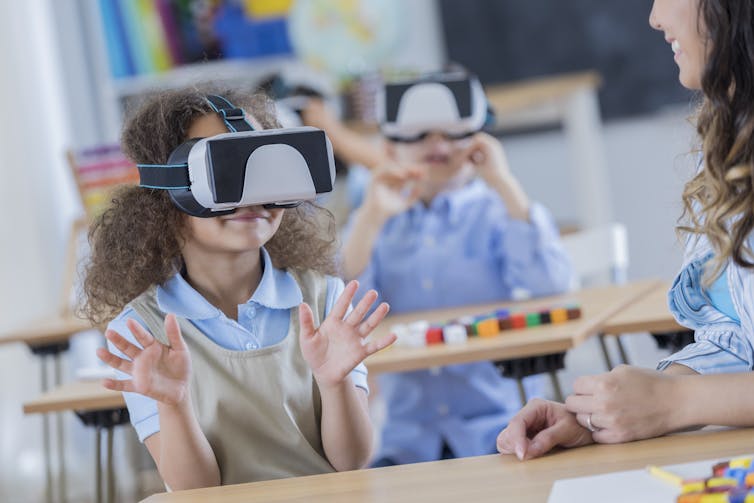5 reasons video games should be more widely used in school
- Written by Andre Thomas, Director - LIVE lab and Associate Professor of the Practice, Texas A&M University
In an effort to curtail how much time young people spend playing video games, China has banned students from playing them during the school week[1] and limits them to just one hour per day on Fridays, weekends and holidays.
The new rule took effect Sept. 1, 2021.
From my standpoint as a video game designer and scholar who specializes in game-based learning[2], I don’t see a need to limit video game play among students during the school week. Instead, I see a need to expand it – and to do so during the regular school day.
Video games are one of the most popular mediums of our times. One estimate shows that by 2025, the global gaming market will amount to US$268.8 billion annually[3] – significantly higher than the $178 billion it is in 2021.
The money spent on gaming does not just facilitate a virtual escape from the real world. Scholars such as James Paul Gee, a longtime literacy professor, have repeatedly shown that video games can be used to facilitate learning[4] in the K-12 classroom. Education writer Greg Toppo[5] reached the same conclusion in his critically acclaimed[6] book, “The Game Believes in You: How Digital Play Can Make Our Kids Smarter[7].”
A long history
 The Oregon Trail, a famous 1970s computer game, taught children about life for Americans traveling to the West during the early 1800s.
Bill O'Leary/The Washington Post via Getty Images[8]
The Oregon Trail, a famous 1970s computer game, taught children about life for Americans traveling to the West during the early 1800s.
Bill O'Leary/The Washington Post via Getty Images[8]
The use of video games in the classroom is nothing new. Many people who went to school in the 1970s through the 1990s may recall the iconic video game The Oregon Trail[9], which made its debut in a classroom in 1971.
In the game, players lead a group of settlers across the Midwest following in the footsteps of Lewis and Clark[10]. The game came just before the video game industry was established[11] with the 1972 release of the video game Pong[12], an electronic version of table tennis.
Even though educational video games have been used in classrooms for 50 years – and despite the fact that research shows educational games can be effective[13] – they are not that common[14] in classrooms today.
Many educational games have been released since the days of The Oregon Trail. Some of the most popular are: Where in the World Is Carmen Sandiego?,[15]Math Blaster![16], Zoombinis[17], iCivics[18], DragonBox Algebra[19] and History Maker VR[20]. Most games are for pre-K to elementary school students.
Here are five reasons why I think video games should be used in every classroom.
1. Video games can help students stay in STEM
In 2020, the President’s Council of Advisors on Science and Technology found that the nation needs to create the STEM workforce of the future[21]. One of the reasons students drop or switch out of science, technology, engineering and math programs is because of the difficulty of introductory courses such as calculus[22].
The University of Oklahoma has developed a calculus game[23] that can help students succeed in calculus. Research has shown student mastery of calculus increases when using a purposeful designed learning game[24], such as Variant: Limits[25] – another calculus game that was developed at Texas A&M University.
2. They provide experiential learning
Teaching students 21st-century skills, such as creative problem solving, is important for the future workforce[26], according to the Organization for Economic Co-operation and Development. Games such as DragonBox Algebra[27], where students solve math problems in a fantasy environment, can help students master skills such as critical thinking[28].
In games such as Civilization[29], players can be a civic leader and direct the prosperity of nations. In ARTé: Mecenas[30], learners can become members of the Medici family[31] and become patrons of the arts and successful bankers. Students learn through doing and can gain skills and knowledge[32] through experiential learning that might not be gained in traditional classrooms.
3. Players learn from failure
Games are a natural way to allow students to fail in a safe way, learn from failures[33] and try again until they succeed.
Some games, like Burnout Paradise[34] make failure fun. In the game, players can crash their cars – and the more spectacular the crash, the higher the points. This allows players to essentially learn from their mistakes, correct them and try again.
The late video game theorist and author Jesper Juul[35] wrote in his book, “The Art of Failure[36],” that losing in video games is part of what makes games so engaging. Failing in a game makes the player feel inadequate, yet the player can immediately redeem themselves and improve their skills.
 Video games can engage students in educational material in a fun way.
SDI Productions/E+ via Getty Images[37]
Video games can engage students in educational material in a fun way.
SDI Productions/E+ via Getty Images[37]
4. Students stay engaged in content
The average time a student spends learning in a classroom is only 60% of the allocated class time[38]. Extending the school day to give students more time for learning has been shown to be only marginally effective[39]. A more effective way to maximize time for learning[40] is through engaged time on task. When students are interested and care about a topic and it is relevant, they are curious and engaged. This provides a much better learning experience.
In the classroom, teachers can engage students. But when it comes to homework, educators have to rely on other ways to motivate students. One way is through games. Educational games can be designed to improve motivation and engagement[41], providing students with more engaged time on task.
[Like what you’ve read? Want more? Sign up for The Conversation’s daily newsletter[42].]
5. Games make complex knowledge fun
Educational theories state that students cannot be given knowledge; they construct knowledge in their own minds. Learners build on previously learned concepts to construct higher-level and more complex knowledge to make it their own[43].
The periodic table of elements[44] is challenging to learn and remember for many students. However, learning a complex three-dimensional matrix[45] with 27,624 values is easily accomplished by middle school students playing the popular video game Pokémon[46]. The essence of the game is figuring out how to combine the 17 different types of attack when battling other Pokémon. Each Pokémon has one or two types of attacks they can use. Players do not learn the different possible combinations by studying a large table with 27,624 entries, but by playing the game. Through playing the game, students gradually construct deeper knowledge of the game and develop core skills[47], such as literacy, how to compete with grace and sportsmanship, and abstract thinking.
Pokémon was not developed as an educational game, but its design principles – and those of other popular video games – could easily be used to design video games for classrooms that enhance their educational experience.
References
- ^ banned students from playing them during the school week (www.washingtonpost.com)
- ^ specializes in game-based learning (scholar.google.com)
- ^ the global gaming market will amount to US$268.8 billion annually (www.statista.com)
- ^ video games can be used to facilitate learning (doi.org)
- ^ Greg Toppo (www.ewa.org)
- ^ critically acclaimed (www.gettingsmart.com)
- ^ The Game Believes in You: How Digital Play Can Make Our Kids Smarter (www.gamebelieves.com)
- ^ Bill O'Leary/The Washington Post via Getty Images (www.gettyimages.com)
- ^ The Oregon Trail (www.smithsonianmag.com)
- ^ footsteps of Lewis and Clark (www.archives.gov)
- ^ was established (www.history.com)
- ^ Pong (americanhistory.si.edu)
- ^ educational games can be effective (us.macmillan.com)
- ^ not that common (joanganzcooneycenter.org)
- ^ Where in the World Is Carmen Sandiego?, (www.carmensandiego.com)
- ^ Math Blaster! (www.mathblaster.com)
- ^ Zoombinis (www.terc.edu)
- ^ iCivics (www.icivics.org)
- ^ DragonBox Algebra (dragonbox.com)
- ^ History Maker VR (www.schellgames.com)
- ^ create the STEM workforce of the future (science.osti.gov)
- ^ calculus (www.maa.org)
- ^ calculus game (learn.k20center.ou.edu)
- ^ increases when using a purposeful designed learning game (today.tamu.edu)
- ^ Variant: Limits (triseum.com)
- ^ important for the future workforce (www.oecd.org)
- ^ DragonBox Algebra (dragonbox.com)
- ^ critical thinking (www.commonsense.org)
- ^ Civilization (civilization.com)
- ^ ARTé: Mecenas (triseum.com)
- ^ Medici family (galileo.rice.edu)
- ^ gain skills and knowledge (doi.org)
- ^ learn from failures (doi.org)
- ^ Burnout Paradise (www.ea.com)
- ^ Jesper Juul (www.jesperjuul.net)
- ^ The Art of Failure (mitpress.mit.edu)
- ^ SDI Productions/E+ via Getty Images (www.gettyimages.com)
- ^ 60% of the allocated class time (doi.org)
- ^ only marginally effective (doi.org)
- ^ maximize time for learning (www.ascd.org)
- ^ can be designed to improve motivation and engagement (doi.org)
- ^ Sign up for The Conversation’s daily newsletter (theconversation.com)
- ^ make it their own (doi.org)
- ^ periodic table of elements (pubchem.ncbi.nlm.nih.gov)
- ^ three-dimensional matrix (pokemondb.net)
- ^ Pokémon (www.pokemon.com)
- ^ develop core skills (dl.acm.org)
Read more https://theconversation.com/5-reasons-video-games-should-be-more-widely-used-in-school-164264

















